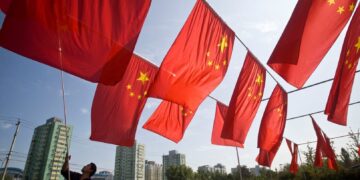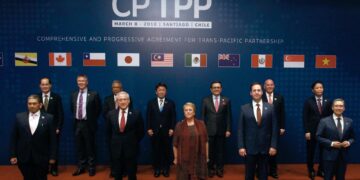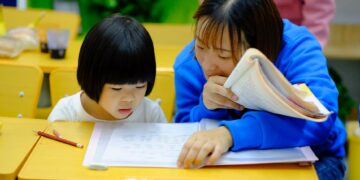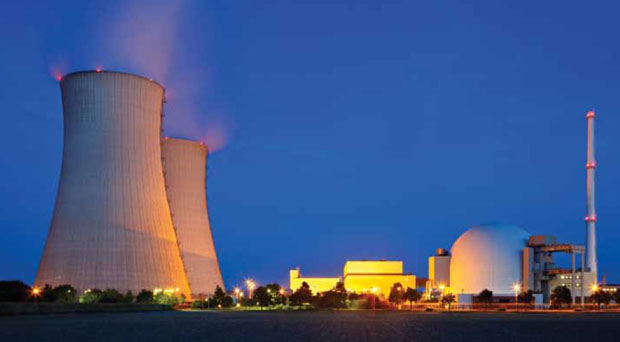China aims to expand its nuclear power industry to reduce air pollution and meet rising demand for electricity.Nuclear power accounts for a small but rapidly growing portion of China’s overall electricity mix and is an area that has received considerable central government attention and effort. At the end of 2009, nuclear power represented only about 1 percent of China’s installed electricity-generating capacity, or roughly 10 gigawatts (GW) of China’s total installed capacity of 950 GW. Electricity from nuclear power comprised only 1.9 percent of China’s total electricity available for consumption in 2007, the most recent year for which official national-level statistics are available. In contrast, hydropower comprised 14.8 percent, and thermal power, including electricity generated by coal and other fossil fuels, accounted for 83.2 percent of electricity generated.
China’s nuclear energy sector is poised for rapid growth, however. Nuclear plants that are currently under construction will, when completed, more than triple China’s 2009 nuclear electricity-generating capacity. This expansion reflects a growing PRC government desire to diversify China’s energy mix by reducing reliance on coal resources and expanding the amount of energy produced by other sources, such as natural gas, wind, hydro, and nuclear.
Central and local governments are interested in developing nuclear power for a variety of reasons. Nuclear plants can be placed nearly anywhere, including in locations far from resource- or weather-dependent energy sources. Many of China’s most populous areas—those that use the most energy—are located along the country’s coast, far from traditional coal and oil supplies in northeastern and northwestern China. Though traditional concerns about nuclear waste have been raised in public discussions in China, the desire for energy sources that meet China’s needs while avoiding further emissions is strong. In November 2009, on the eve of the Copenhagen climate summit, PRC leaders committed to reduce China’s carbon intensity per unit of gross domestic product (GDP) by 40 to 45 percent of 2005 levels by 2020. Nuclear power does not produce greenhouse gases or other types of air pollution and thus could help China meet commitments for reducing carbon output.
Nuclear power in China’s development plans
China’s development plans—including the five-year plans (FYPs) that guide the country’s overall development—have targeted nuclear power as an industry for development for several decades. China’s Sixth FYP (1981-85) called for the country to establish 0.3 GW of nuclear capacity by 1985, and the Eighth FYP (1991-95) increased the nuclear energy capacity target to 0.6 GW and encouraged development of Qinshan Phase II. Since 2001, however, support for the sector has increased rapidly:
- The Tenth FYP (2001-05) established targets for China’s annual nuclear power capacity to grow 30 percent each year from 2001-05 and hit 600 gigawatt hours by 2005. The plan also called for Sino-foreign cooperation in the industry and encouraged domestic industry to develop new nuclear technology.
- The Eleventh FYP (2006-10) called for the country to actively support its nuclear power industry and proposed the construction of nuclear reactors at four new sites.
- The PRC State Council 2005-20 Nuclear Power Development Plan (adopted in 2007) set targets for installed nuclear capacity of 40 GW by 2020, a target that has since been raised. The plan also called for the expansion of nuclear capacity by 2 GW each year through 2010 and by 4 GW per year afterward for the duration of the plan.
- The Catalogue Guiding Foreign Investment in Industry (released in 2002, revised in 2007, and slated to be revised again this year) includes certain nuclear materials and equipment—including zirconium sponge, special pumps and valves, sealing elements, forging parts, and magnetic resonance spectrometers—and “construction and management” support under the “encouraged” category, which may make foreign investment in these sectors eligible for tax breaks or other preferential treatment. Foreign investment in some of these areas is limited to joint ventures, however.
- The Guiding Catalogue for the Adjustment of Industrial Structure (released in 2005 by the PRC National Development and Reform Commission [NDRC]) guides the development of domestic industry. Like the foreign-investment catalogue, the domestic catalogue lists nuclear energy as an “encouraged” industry. It targets several specific technologies for development, including nuclear power plant construction, radiation protection technology and monitoring equipment, and certain types of nuclear reactors. Separately, the catalogue includes nuclear energy—along with wind, solar, and tidal power—as a form of “clean energy” to be developed.
As China has met previously stated goals, it has revised plan targets upward. In early 2008, PRC officials raised their projections for China’s installed nuclear capacity to 60 GW and for nuclear power to account for 5 percent of electricity production by 2020. In July 2009, China Daily reported that the State Council was considering raising the 2020 target to 86 GW of installed capacity, and recent statements reported in the Western press indicated that a revised nuclear plan in the works would raise capacity targets to more than 70 GW by 2020.
Some of these proposals have listed specific technologies; others are in the preliminary stages of development and provide few details.
The nuclear power sector landscape
China’s major nuclear-industry players are domestic state-owned enterprises. Along with China’s other energy giants, they are collectively tasked with developing China’s energy capacity and play a strong role in guiding the industry’s development.
China National Nuclear Corp. (CNNC)
CNNC is the largest player in China’s nuclear industry. It has major investments across the nuclear supply and development chain, including in research and development, engineering design, uranium exploration and mining, nuclear material enrichment, fuel fabrication, waste reprocessing, and disposal. CNNC—directly or through its more than 100 subsidiaries—is also the majority investor in all of China’s nuclear power plants. It is highly influential in China’s nuclear sector and has been a key advocate for domestic technology and designs in the country’s nuclear power plants. CNNC operates existing nuclear facilities in Zhejiang and Jiangsu and will lead planned projects in those provinces, as well as in Fujian and Hunan.
China Guangdong Nuclear Power Corp. (CGNPC)
CGNPC is the leading nuclear power plant operator in southern China and operates through more than 20 subsidiaries. The company was originally established in 1994 with funding from the Guangdong provincial government (45 percent), CNNC (45 percent), and China Power Investment Corp. (10 percent). CGNPC manages the Daya Bay and Ling’ao reactors in Guangdong, as well as planned projects in Anhui, Fujian, Hubei, and Liaoning.
China Power Investment Corp. (CPIC)
CPIC is a major power generator and is the largest wholly state-owned nuclear power holding company. CPIC will oversee new plants in Hunan, Jiangxi, and Shandong.
State Nuclear Power Technology Corp. (SNPTC)
SNPTC was created in 2004 with investment from the PRC State Council (60 percent) and CGNPC, CNNC, CPIC, and China National Technical Import and Export Corp. SNPTC is responsible for signing contracts with foreign parties to receive transferred technology and oversees management of nuclear projects that involve foreign parties. In the past, SNPTC has advocated for greater foreign involvement in China’s nuclear industry and played a significant role in ensuring that the 2004 bidding process for nuclear plants targeted foreign technology.
Technology platforms for nuclear power
China has 11 nuclear power reactors at four sites: Daya Bay and Ling’ao, Guangdong; Qinshan, Zhejiang; and Tianwan, Jiangsu. China has approved or started the construction of several other nuclear power plants which, when completed, will more than double the number of plants (see Tables 1 and 2).
Most of China’s nuclear reactors use technology developed or adapted in China, including the CNP and CPR model lines. CNNC developed the CNP model line from Chinese technology, while CGNPC developed the CPR-1000 design based on designs and intellectual property provided by Framatome Group, a subsidiary of France-based Areva SA. Other existing reactors use largely foreign-sourced technology: Candu-6 (used in Qinshan’s Phase 3 reactors) was developed by Atomic Energy of Canada Ltd., and VVER (used in the Tianwan reactors) was developed by Russia-based AtomStroyExport. Most of China’s nuclear energy facilities use pressurized water technology.
Nuclear projects under construction also use a mix of technology developed in or adapted for China. The majority use the domestically developed CNP and CPR lines with the most commonly used design being the CPR-1000. All of these projects are located in coastal provinces, with most in southern and eastern China. The Ningde Nuclear Power Plant in Fujian is a typical example. Approved by NDRC in September 2006, the plant will be located in northeastern Fujian. The project is controlled and operated by CGNPC. Construction began in February 2008 using CPR-1000 reactor technology, and Ningde 1 is expected to begin operations in 2012.
China is seeking more advanced nuclear technology, however, some of which only foreign companies can currently provide. In September 2004, the State Council approved plans for four new nuclear reactors in eastern China, with the requirement that participants bid using 1 GW to 1.5 GW reactors of generation III or higher technology. China’s State Nuclear Power Technology Corp. (SNPTC), supervised by the State Council, was tapped to select the foreign technology to use at these plants. During an open bidding process, three foreign companies submitted bids: US-based Westinghouse Corp. (AP1000 reactors), AREVA (EPR reactors), and AtomStroyExport (VVER-1000 reactors). In December 2006, after months of bidding and technical exchanges, Westinghouse’s AP1000 design was selected for four plants in Sanmen, Zhejiang; and Haiyang, Shandong. AREVA was later selected to build two separate units in Taishan, Guangdong.
Since the initial designation of AP1000 reactor technology for the Sanmen and Haiyang plants, AP1000 has been selected for China’s first four non-coastal nuclear power plants in Dafan, Hubei; Xiaomoshan and Taohuajiang, Hunan; and Pengze in Jiangxi. Construction on all four plants is expected to begin in 2010, but information about whether these projects had broken ground was unavailable as CBR went to press.
China’s nuclear future
China’s goals for developing nuclear energy are ambitious. Development plans and follow-up statements reflect the desire of PRC officials to find reliable sources of energy that can meet soaring demand without worsening existing environmental problems. China’s success in meeting ever-higher nuclear capacity targets gives reason to believe that the Twelfth FYP (2011-15), which was still being drafted as CBR went to press, could call for even more nuclear capacity.Though there have been no concrete indications of how the new FYP will treat nuclear energy, several provincial-level entities have already stated their intention to submit nuclear projects for approval and inclusion in the plan. China’s nuclear ambitions presents considerable opportunities for foreign companies that offer advanced nuclear technology.
[box]
PRC Nuclear Regulatory Approval Agencies
- China Atomic Energy Authority (CAEA) is responsible for planning the short- and long-term development of China’s civil nuclear industry. CAEA reviews nuclear power plant feasibility studies and submits recommendations to the PRC National Development and Reform Commission (NDRC) for final approval.
- National Nuclear Safety Administration functions under the umbrella of CAEA as the main licensing and regulatory body for nuclear safety and plant operation. It is also responsible for maintaining international nuclear safety agreements.
- NDRC has broad responsibility for China’s macroeconomic planning and oversees the energy sector through the National Energy Administration (NEA). NDRC retains ultimate authority for approval of major nuclear projects.
- NEA works under the NDRC and is tasked with ensuring China’s energy supply and energy security, as well as overseeing and managing the energy sector.
- Ministry of Environmental Protection handles safety and regulation of the materials used in China’s nuclear power plants.
—Ryan Ong[/box]
[box]
Navigating US Export Controls
US companies that want to sell to China’s nuclear industry must deal with the US export control regime, which involves several US agencies. The process of exporting nuclear technology involves four main agencies:
- Department of Energy (DOE) Companies that want to transfer nuclear technology or provide technical assistance for the nuclear fuel cycle must first consult with the International Regimes and Agreements Office, under the DOE’s National Nuclear Safety Administration (NNSA). If the export involves transmission of proprietary or export-controlled information, companies must obtain a letter of approval, known as the “Part 810 process.” Companies must also consult with NNSA and the Department of State’s Directorate of Defense Trade Controls to ensure compliance with the US 123 Agreement with China, which allows US parties to export certain nuclear products—including reactors, source and special materials, and some components—for peaceful, commercial purposes under Section 123 of the US Atomic Energy Act of 1954.
- Nuclear Regulatory Commission (NRC) Companies looking to import or export nuclear equipment, materials, or facilities that will produce or use nuclear technology must submit a formal license application to the NRC’s Office of International Programs. This is known as the “Part 110 process.” (NRC works with the Department of State to coordinate a broader interagency review, but companies typically do not need to reach out to this department separately.)
- Department of Commerce (DOC) Companies must consult with DOC throughout the export controls and licensing processes and can also use DOC’s export promotion services. Companies that want to export dual-use nuclear products, which can include not only hardware for nuclear plants but also detectors and analytical equipment—must consult with DOC’s Bureau of Industry and Security (BIS) to apply for an export license.
- Department of State Companies that want to export nuclear products, services, or data that fall under the US Arms Controls Export Act of 1976 and its related International Traffic in Arms regulations must first register their products with and obtain approval from the Department of State’s Directorate of Defense Trade Controls.
—Ryan Ong[/box]
[box]
Modular Reactor Development in China
China’s nuclear development to date has mainly focused on large reactors that use pressurized water technology. Global nuclear companies and government officials have been paying increasing attention to the development of small modular reactors (SMR), however. SMRs generate less power but are easier to build, install, and maintain. Given China’s power needs and the logistical challenges of long-distance power transmission, SMRs may be especially attractive to PRC officials.
Of China’s existing and approved power plants, only one—the Shandong-based Shidaowan 210 megawatts electric demonstration plant—uses modular technology. Though details of the Shidaowan reactor’s status were unclear as CBR went to press, construction was expected to begin in early 2010. The project will use a pebble bed module high-temperature reactor (HTR-PM). China Huaneng Group, China Nuclear Engineering and Construction Group, and Qinghua University’s Institute of New Energy Technology will jointly fund this project. Whether the development of other SMRs will be encouraged in China’s Twelfth Five-Year Plan (2011-15) remains to be seen.
—Ryan Ong[/box]
[author]Ryan Ong is director of Business Advisory Services at the US-China Business Council in Washington, DC.[/author]

































